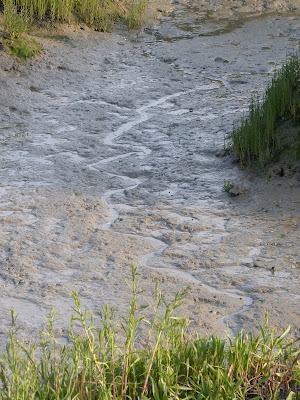When we arrived it was approaching high tide and you could see the beds that were used to filter the oysters before cleaning and packing.
Inside the Packing Shed there is a small collection from its working days. These wooden boards were worn on your feet to stop you sinking into the deep mud that surrounds the island.
This gentleman joined us at the table and told us about the history of The Packing Shed. He bought examples of oyster shells and told how the local oysters were devastated by disease on several occasions. The last survivors were sadly lost in the 1963 winter when this area of the coast froze over. Stocks were replenished from other sources and they have gradually re-established. Meantime it was suggested that oysters from Portugal was also introduced. These are a much larger variety and fairly resistant to disease, and so far stocks are doing well and traditional oyster fishing continues. We also learnt that the 'slipper limpet' was bought into local waters by US ships during WWII. Because these encrusted the bottom of the ship and slowed them down, they dragged them off using chains. The limpets have since grown in huge numbers, and frequently seen around the coast.
We could still walk around the last narrow stretch, being careful of the resident birds.

Maybe the time passed quickly because we enjoyed learning about the island and exploring, and it didn't seem long before we spotted the tell tale sign of the tide turning. We saw Samphire growing in abundance, a delicacy more seen in restaurants than in shops.
And once again island revealed the oyster filter beds, and The Packing Shed said goodbye to its visitors until next time.
Something I learnt during my visit was the importance of this spit of land and the two small islands that lie next to it. Together these protect the main harbour and fishing grounds of East Mersea, reducing the silt and coastal erosion. I've read about this is the book 'How to Read Water' but it never occurred to me that these small islands so far from shore could have such an impact. So, granite and sea shells have been added to raise the height and stabilise The Packing Shed island, and more is planned in the near future. It was also interesting to learn that the shells come from local waters to maintain ecology, and that the granite is also carefully chosen too. It was a wonderful visit and the weather was just perfect with blue skies and a cooling breeze. I am already looking forward to my next visit!
This post is part of a project in an attempt to learn 'How to Read Water'. It includes daily observations and visits to local rivers over a 30 day period. You can read more about it here.






































